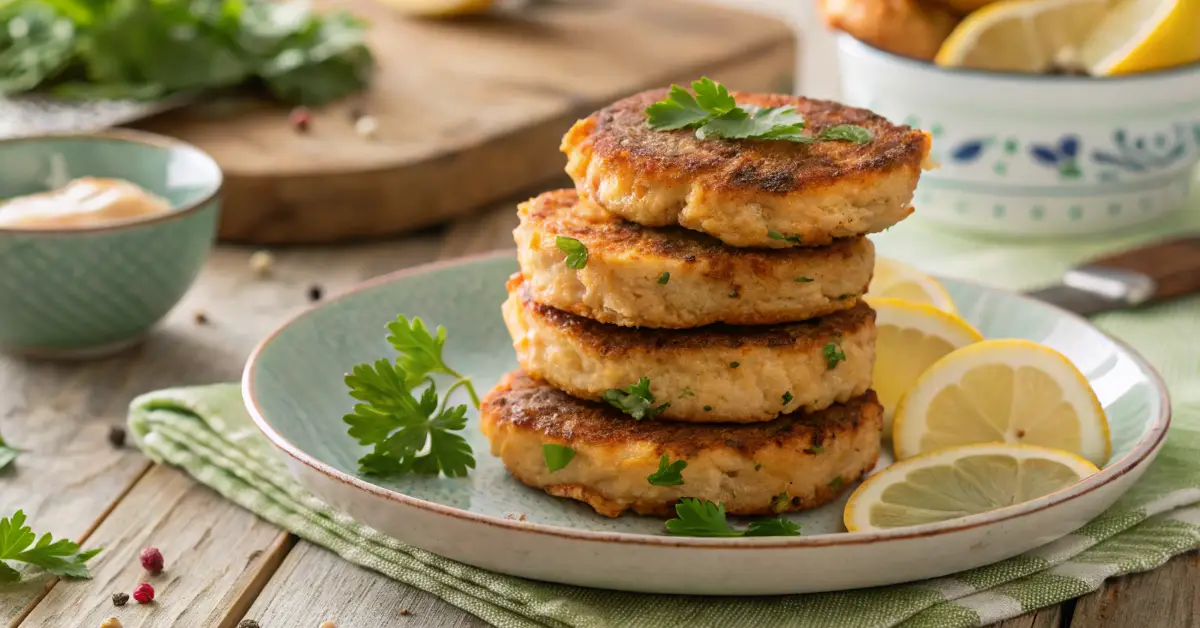Looking for a quick, flavorful dinner that doesn’t require a long grocery list? This salmon cake recipe is exactly what you need. Made with simple pantry staples like canned salmon, breadcrumbs, and a handful of fresh herbs, these crispy cakes come together in under 30 minutes—perfect for busy weeknights or light weekend meals. Whether you’re a seafood lover or just trying to eat more protein-packed dishes, these salmon cakes check all the boxes. They’re crispy on the outside, tender on the inside, and full of savory, zesty flavor in every bite.
In this post, I’ll walk you through everything you need to make the best salmon cakes—from ingredients and step-by-step instructions to cooking methods and storage tips. Whether you’re serving them as a main course, prepping meals ahead of time, or looking for a crowd-pleasing appetizer, this recipe is a reliable go-to.
Why You’ll Love This Salmon Cake Recipe
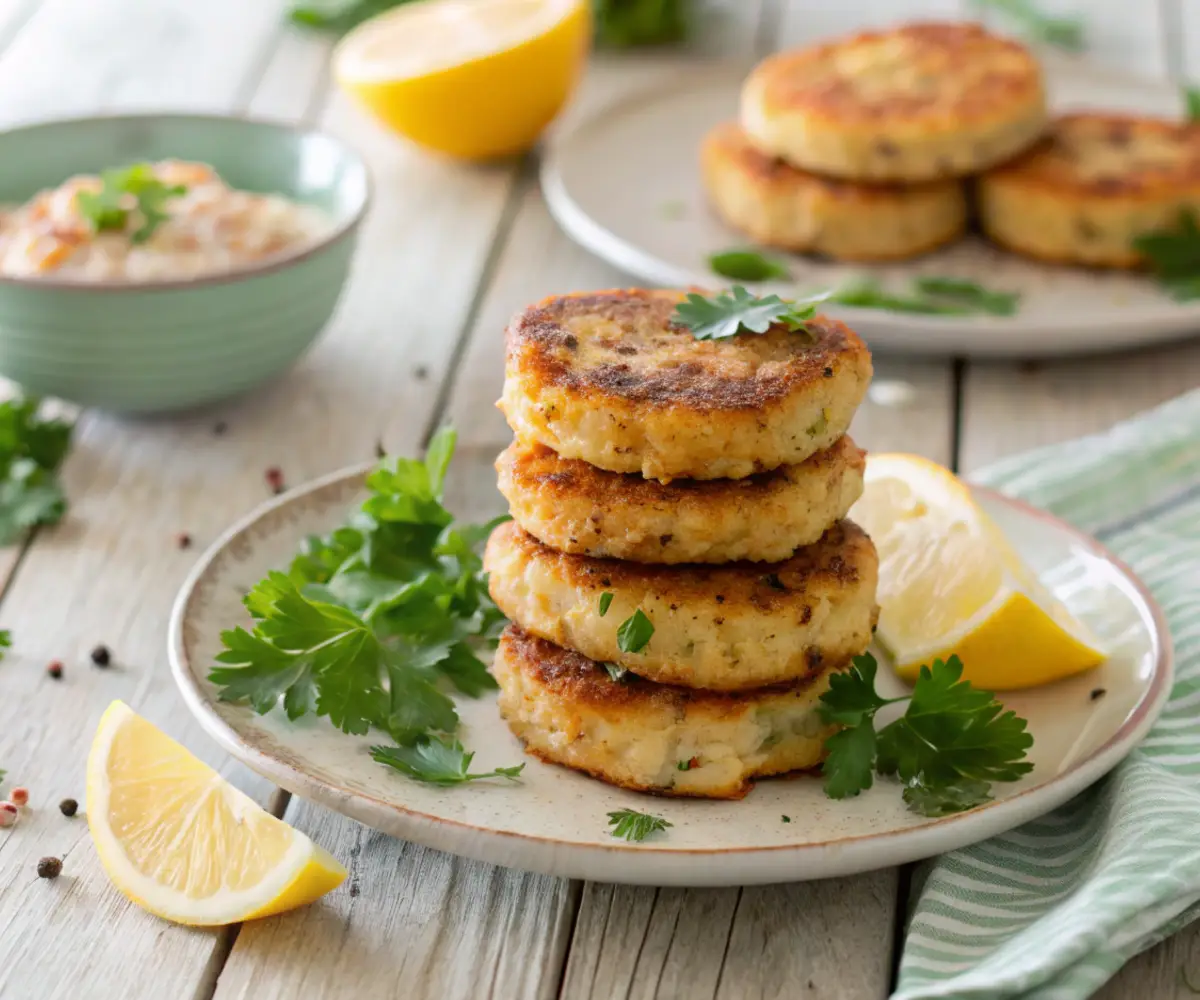
Salmon cakes are the perfect blend of convenience and comfort. Whether you’re cooking for a weeknight dinner or preparing an easy meal prep option, this recipe delivers bold flavor without requiring much time or effort. Here’s why it deserves a regular spot in your meal rotation:
Quick and Easy with Pantry Staples
One of the best things about this salmon cake recipe is how fast and simple it is to prepare. All you need are a few basic ingredients—many of which are probably already in your kitchen. Using canned salmon cuts down on prep time, making this a reliable option when you need a last-minute meal. No fancy equipment or long cooking time required—just mix, shape, and pan-fry or bake for golden perfection.
This is the kind of recipe that feels elevated, yet takes less than 30 minutes to pull together. With minimal chopping and easy cleanup, it’s ideal for beginners and seasoned home cooks alike.
Perfect for Any Meal
These salmon cakes are incredibly versatile. Serve them as a light lunch with a crisp salad, pair them with roasted vegetables for dinner, or tuck them into sliders for a fun appetizer. They also store and reheat well, making them great for meal prep or batch cooking.
Because they’re made with high-protein salmon and customizable seasonings, they fit into a variety of diets—low carb, pescatarian, or even gluten-free with a simple breadcrumb swap. The fresh lemon, herbs like dill or parsley, and a creamy dipping sauce on the side bring everything together for a meal that’s both nourishing and full of flavor.
Whether you’re feeding your family or making a quick solo lunch, this salmon cake recipe is a go-to for easy, delicious seafood that never disappoints.
Ingredients You’ll Need for Salmon Cakes
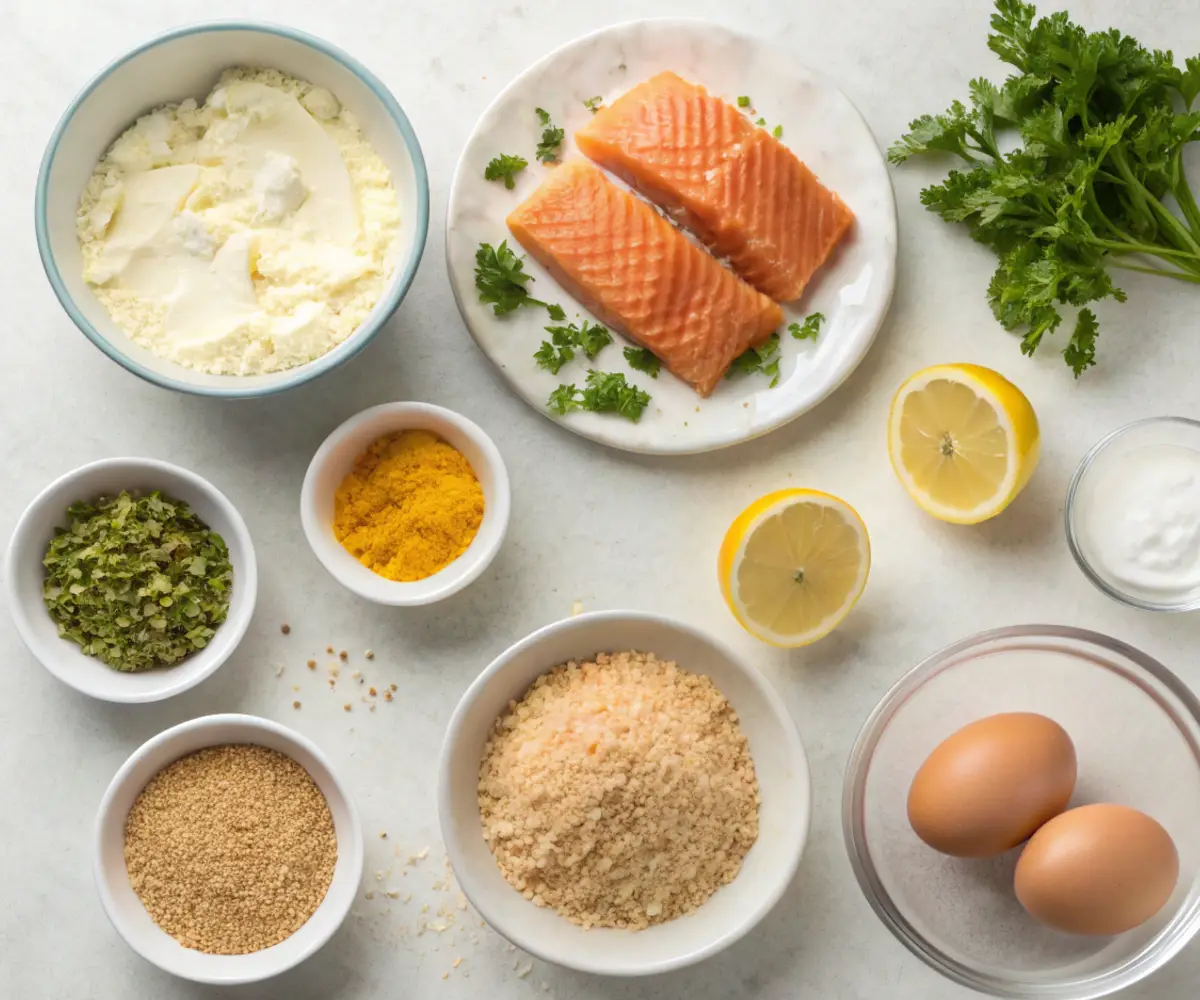
These salmon cakes come together with a handful of simple, affordable ingredients—many of which are kitchen staples. Whether you’re using canned salmon for convenience or fresh salmon for a richer flavor, this recipe is designed to be flexible, delicious, and easy to adapt.
Key Ingredients Explained
Salmon
You can use either canned salmon or cooked fresh salmon, depending on what you have on hand. Canned salmon is budget-friendly, shelf-stable, and incredibly convenient, making it ideal for a quick dinner or meal prep. Just be sure to drain it well and remove any skin or bones, if present. If you have leftover cooked salmon, it works just as beautifully in this recipe.
Breadcrumbs
Breadcrumbs act as a binder and help give the salmon cakes structure. You can use traditional breadcrumbs, panko for extra crunch, or even crushed crackers. For a gluten-free option, swap in almond flour or gluten-free panko.
Egg
The egg is essential for binding all the ingredients together, keeping your salmon patties firm and cohesive while cooking.
Mayonnaise or Greek Yogurt
Mayonnaise adds creaminess and moisture to the mixture, but Greek yogurt is a great alternative if you’re looking for a healthier or lighter option. Either choice keeps the salmon cakes tender and flavorful inside.
Lemon Juice and Zest
Fresh lemon adds a burst of brightness that balances the richness of the salmon. A little zest goes a long way in enhancing flavor without overpowering the dish.
Fresh Herbs
Chopped dill, parsley, or chives bring freshness and color to the mix. Dill is especially complementary to seafood and adds a classic touch.
Seasonings
Salt, pepper, garlic powder, and a touch of onion powder are all you need to boost the flavor of the cakes. You can also add a dash of smoked paprika or Old Bay seasoning for extra depth.
Tools for Success
Mixing Bowl and Spoon
A large mixing bowl makes it easy to combine the ingredients evenly without overworking the mixture. A wooden spoon or spatula will help gently fold everything together.
Cast Iron or Nonstick Skillet
For pan-frying, a well-heated cast iron skillet gives the best crispy edges, but a nonstick skillet also works great with less oil. If you prefer a lighter option, you can bake the salmon cakes on a parchment-lined baking sheet.
Measuring Cups and Spoons
Precise measurements ensure the cakes hold together properly and deliver balanced flavor in every bite.
With these ingredients and tools in hand, you’re all set to create salmon cakes that are crispy, tender, and packed with fresh, zesty flavor. In the next section, we’ll walk through the step-by-step process to make them perfectly every time.
How to Make the Best Salmon Cakes
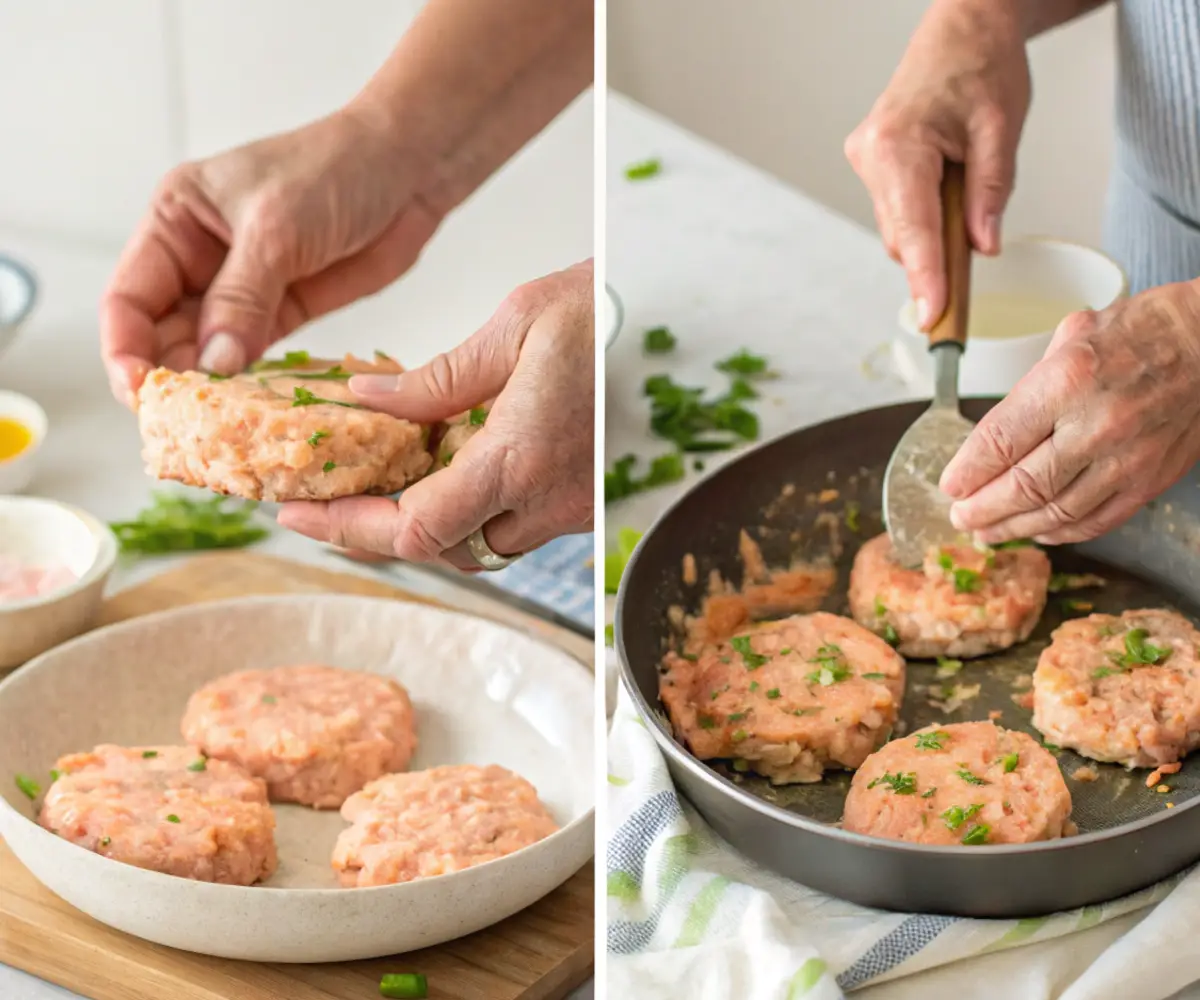
Making homemade salmon cakes is quick, easy, and incredibly rewarding. With a few simple steps, you’ll have crispy, golden cakes that are moist on the inside and packed with savory flavor. Whether you prefer to pan-fry for a crispy crust or bake for a lighter version, this recipe is versatile enough to suit your cooking style.
Mixing and Shaping the Cakes
Start by preparing your salmon. If you’re using canned salmon, drain it well and flake it with a fork, removing any bones or skin. If you’re using cooked fresh salmon, break it into small chunks. Place the salmon in a large bowl.
Add the binding ingredients—breadcrumbs and a beaten egg—along with your moisture component, such as mayonnaise or Greek yogurt. These help hold everything together while adding richness and creaminess.
Now it’s time for flavor. Add in chopped fresh herbs like parsley, dill, or chives, along with a squeeze of lemon juice, a bit of lemon zest, salt, pepper, and seasonings like garlic powder or onion powder. For extra flavor, you can also mix in a dash of smoked paprika, Dijon mustard, or even a few red pepper flakes if you like some heat.
Gently mix the ingredients with a fork or spoon until just combined—avoid overmixing, which can make the cakes tough. Use your hands to form the mixture into evenly-sized patties, about ½ to ¾ inch thick. You should get around 6–8 cakes, depending on size.
Cooking Methods: Pan-Fried or Baked
Once your salmon cakes are shaped, you have two main cooking options: pan-frying or baking.
Pan-Frying:
Heat a few tablespoons of olive oil or butter in a skillet over medium heat—cast iron works especially well for even browning. Once hot, add the salmon cakes and cook for about 3–4 minutes per side, or until golden brown and crispy. Avoid crowding the pan to ensure even cooking.
Baking:
For a lighter version, preheat your oven to 400°F (200°C). Arrange the cakes on a parchment-lined baking sheet, lightly brush or spray with oil, and bake for 12–15 minutes per side, or until golden and firm. Baking is a great hands-off option and also works well if you’re making a larger batch.
No matter which method you choose, these crispy salmon cakes come out flavorful and satisfying. Serve them hot with a squeeze of lemon and your favorite dipping sauce, like tartar, aioli, or even sriracha mayo for a spicy kick.
In the next section, we’ll cover how to serve these salmon cakes and the best ways to store and reheat any leftovers.
Serving Suggestions and Storage Tips
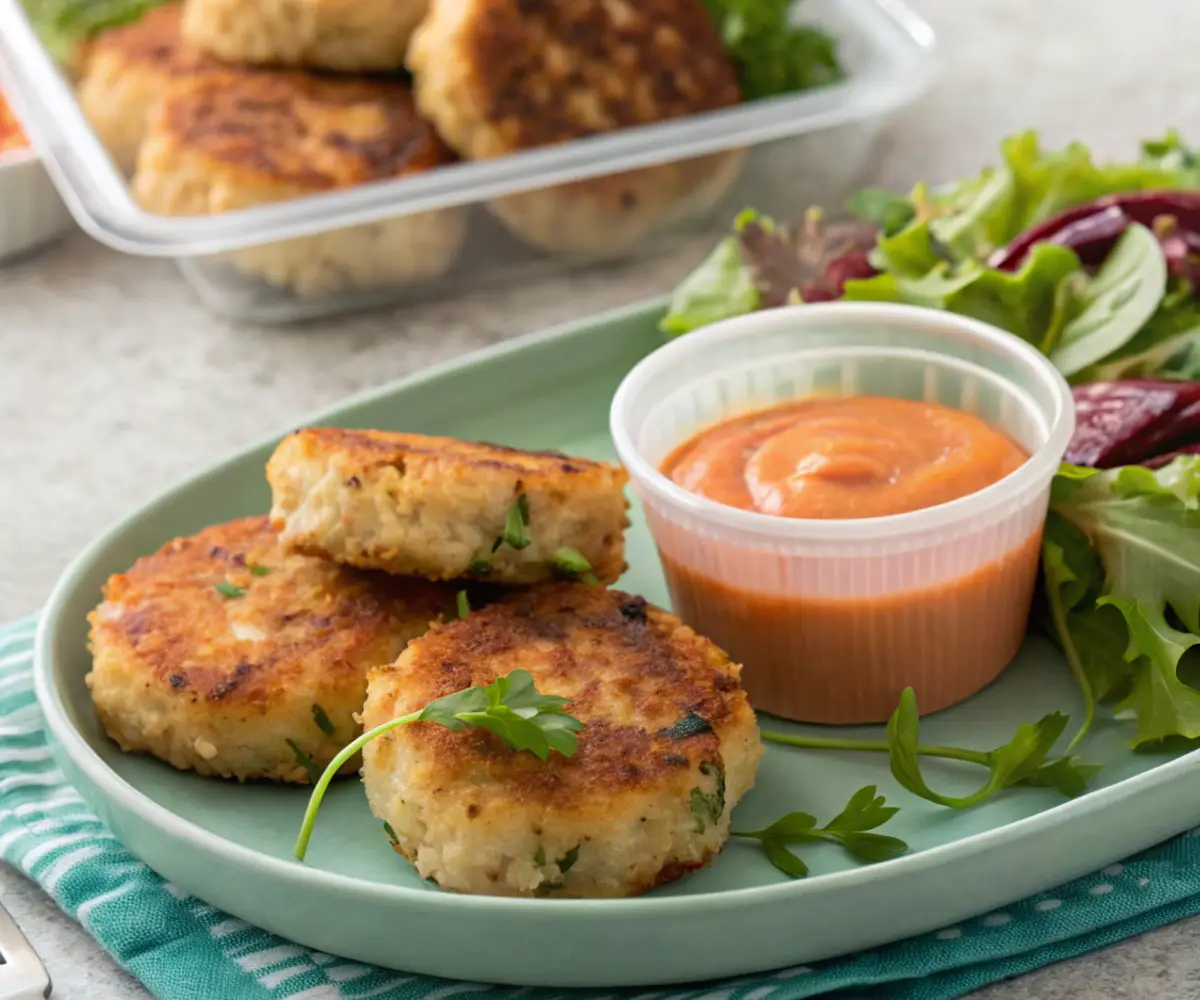
Once you’ve cooked your salmon cakes to golden perfection, it’s time to enjoy them. These flavorful cakes are incredibly versatile and can be served in a variety of ways—whether you’re planning a full dinner, prepping a meal for later, or creating a casual appetizer spread.
How to Serve Salmon Cakes
As a Main Course
Serve your salmon cakes warm with a side of roasted vegetables, mashed potatoes, or a simple green salad. For a wholesome seafood dinner, pair them with steamed asparagus, sautéed spinach, or a lemony quinoa pilaf. A dollop of creamy tartar sauce, garlic aioli, or a tangy yogurt dill dip adds a delicious finishing touch.
In a Sandwich or Wrap
Turn these salmon cakes into a satisfying sandwich by placing one between a toasted bun with lettuce, tomato, and a drizzle of spicy mayo or remoulade. You can also wrap them in a warm pita or tortilla with fresh greens and a squeeze of lemon for a Mediterranean-style lunch.
As an Appetizer or Snack
Make mini salmon cakes or sliders for a crowd-pleasing party appetizer. Serve them with dipping sauces like sweet chili sauce, tzatziki, or mustard mayo. They also pair well with pickled vegetables or a light slaw for a refreshing bite.
Low-Carb Option
For a light and low-carb meal, serve the cakes over a bed of arugula or baby spinach, drizzled with olive oil and lemon juice. You’ll get all the protein and flavor without the added carbs.
Storing and Reheating
Refrigerating Leftovers
Allow the salmon cakes to cool completely, then store them in an airtight container in the refrigerator. They’ll stay fresh for up to 3–4 days. Place parchment paper between layers to prevent sticking if stacking.
Freezing for Later
These salmon cakes freeze beautifully. Lay the cooked cakes in a single layer on a baking sheet and freeze until solid, then transfer to a zip-top freezer bag or freezer-safe container. Label and store for up to 2 months. For best results, thaw overnight in the fridge before reheating.
Reheating Tips
To keep the texture crispy, reheat salmon cakes in a skillet over medium heat for a few minutes per side or warm them in a 375°F (190°C) oven for 10–12 minutes. Avoid the microwave if possible, as it can make the cakes soggy.
With these storage and reheating tips, you can easily make salmon cakes ahead of time and enjoy them throughout the week—perfect for meal prep or quick lunches.
Frequently Asked Questions (FAQs)
How do you keep salmon moist when baking?
To keep salmon moist while baking, avoid overcooking and use moisture-retaining ingredients like olive oil, mayonnaise, or yogurt. When making salmon cakes, adding ingredients like Greek yogurt, egg, and a bit of lemon juice helps maintain tenderness. Baking at the right temperature—typically 375°F to 400°F—also ensures the cakes stay moist inside while crisping up on the outside.
What are the ingredients in salmon cakes?
The essential ingredients for salmon cakes include canned or cooked salmon, breadcrumbs, egg, mayonnaise or Greek yogurt, lemon juice, fresh herbs (like dill or parsley), and seasonings such as garlic powder, salt, and pepper. Some variations may also include chopped onions, Dijon mustard, or red pepper flakes for added flavor.
How do you keep salmon cakes from falling apart?
To prevent salmon cakes from falling apart, use binding ingredients like eggs and breadcrumbs in the right ratio. Be sure to drain excess moisture from the salmon and avoid overmixing the batter. Letting the shaped patties chill in the fridge for 15–30 minutes before cooking also helps them firm up and hold their shape when heated.
What holds salmon patties together?
Salmon patties are held together by a combination of binding ingredients, primarily eggs and breadcrumbs. Mayonnaise or Greek yogurt adds additional moisture and structure, while refrigerating the mixture before cooking helps the cakes stay intact. These ingredients ensure your salmon cakes are easy to shape, cook evenly, and hold together from skillet to plate.
Conclusion
In just a few simple steps, you can create the best ever salmon cakes—crispy on the outside, tender and flavorful on the inside. Whether you’re making them for a quick dinner, meal prep, or a party appetizer, these salmon cakes are guaranteed to satisfy. The combination of fresh herbs, savory seasonings, and the natural richness of salmon makes each bite deliciously comforting and full of flavor.
With the flexibility to be pan-fried or baked, and the ability to easily customize the ingredients, this recipe is perfect for everyone, from beginners to experienced cooks. Pair your salmon cakes with your favorite sides or sauces, and you have a meal that’s as versatile as it is tasty.
So next time you’re looking for a quick, nutritious, and crowd-pleasing meal, look no further than this simple, delicious, and fast salmon cake recipe. Happy cooking!
Explore More Recipes: Visit Cucina Recipes to find even more delicious meal ideas to inspire your next cooking adventure!
Did you make this recipe?
Mention @cucinarecipes or tag #cucinarecipes!

